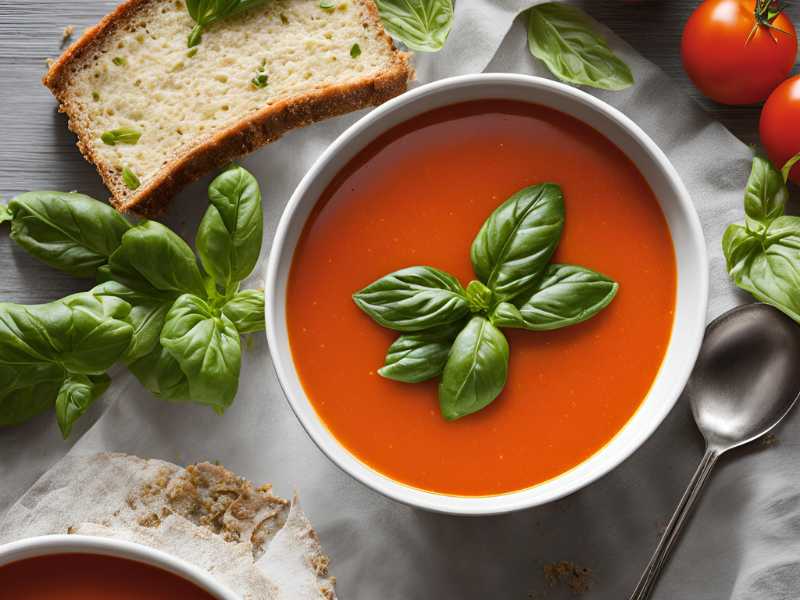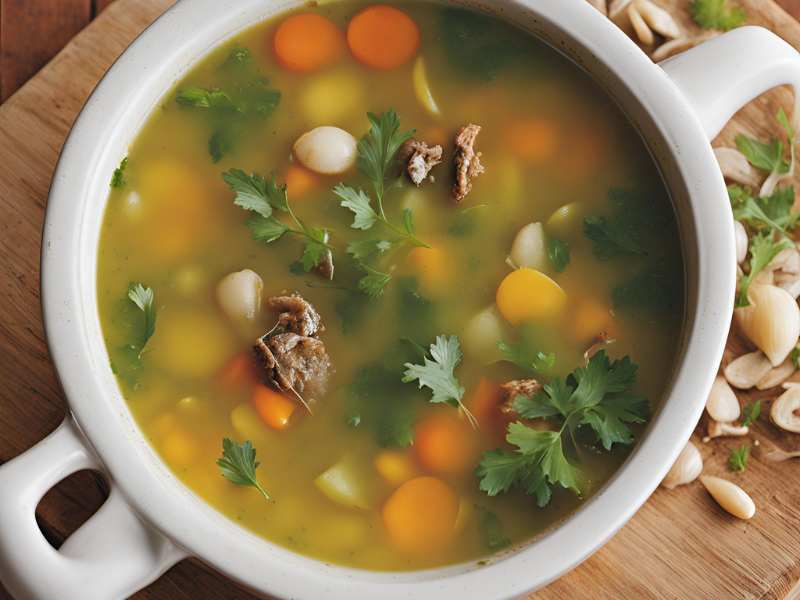Abiotic factors might not be the first thing that comes to mind when you think of a comforting bowl of soup, but these essential, non-living components of ecosystems—such as temperature, minerals, sunlight, and water—play a crucial role in shaping the natural world. They affect the ingredients that grow, how food is cultivated, and even the kinds of flavors we find comforting. Inspired by these abiotic elements, let’s dive into some delicious soup recipes that highlight different aspects of the natural environment. These recipes are not only flavorful but also offer a unique way to connect to the natural elements that shape the ingredients we use every day.
Different Types of Soup Recipes Abiotic Factors
- Solar-Powered Tomato Basil Soup
- Mineral-Rich Mushroom and Barley Soup
- Glacier-Inspired Cold Cucumber and Dill Soup
- Sun and Soil Roasted Root Vegetable Soup
Here we are going to provide detail information of these four Soup Recipes Abiotic Factors
1. Solar-Powered Tomato Basil Soup
This light and bright soup is inspired by the importance of sunlight as an abiotic factor. Sunlight powers the growth of the tomatoes and basil that form the backbone of this comforting soup. This dish is best enjoyed on a sunny day when the warmth and brightness of the ingredients truly shine.

Ingredients:
- 2 tablespoons olive oil
- 1 medium onion, diced
- 3 cloves garlic, minced
- 6-7 large ripe tomatoes, roughly chopped (or 2 cans of whole peeled tomatoes)
- 3 cups vegetable broth
- 1/2 teaspoon sugar (to balance acidity)
- Salt and black pepper to taste
- 1/2 cup fresh basil leaves, roughly chopped
- 1/4 cup heavy cream or coconut milk (optional for a creamy finish)
Instructions:
- Heat the Oil: In a large pot, heat the olive oil over medium heat. Add the onion and sauté for about 5-7 minutes, until softened.
- Add Garlic and Tomatoes: Add the garlic and cook for an additional minute until fragrant. Stir in the chopped tomatoes and cook for another 10 minutes, allowing them to break down.
- Simmer with Broth: Pour in the vegetable broth, season with salt, pepper, and sugar. Let it simmer for 20 minutes.
- Blend the Soup: Use an immersion blender to blend the soup until smooth (or transfer to a blender and carefully blend in batches).
- Add Basil and Finish: Stir in the fresh basil leaves and cream if using, and simmer for an additional 5 minutes. Serve warm with a drizzle of olive oil and crusty bread.

Connection to Sunlight: Tomatoes and basil are sun-loving plants, and this soup celebrates the flavors that thrive under the sun’s warmth.
2. Mineral-Rich Mushroom and Barley Soup
This hearty mushroom and barley soup pays tribute to minerals, an essential abiotic factor present in soil and water. The rich, earthy flavor of mushrooms and the nutty barley make this a perfect comfort food that’s deeply connected to the nutrient-rich soil in which the ingredients grow.

Ingredients:
- 2 tablespoons butter or olive oil
- 1 onion, finely chopped
- 2 carrots, peeled and sliced
- 2 stalks celery, sliced
- 3 cloves garlic, minced
- 8 oz cremini or button mushrooms, sliced
- 1/2 cup pearl barley
- 6 cups vegetable or beef broth
- 2 teaspoons soy sauce
- 1/2 teaspoon dried thyme
- Salt and black pepper to taste
- 2 tablespoons chopped fresh parsley (for garnish)
Instructions:
- Sauté Vegetables: Heat the butter in a large pot over medium heat. Add the onion, carrots, and celery, cooking for about 5 minutes until they begin to soften.
- Add Garlic and Mushrooms: Stir in the garlic and sliced mushrooms, cooking for another 5-7 minutes until the mushrooms release their moisture and begin to brown.
- Add Broth and Barley: Pour in the broth, add the barley, soy sauce, thyme, salt, and pepper. Stir well to combine.
- Simmer: Bring the mixture to a boil, then reduce the heat to low and cover. Let it simmer for about 45 minutes or until the barley is tender.
- Garnish and Serve: Stir in the fresh parsley before serving. Enjoy this hearty soup with a sprinkle of black pepper on top.
Connection to Minerals: This soup celebrates the connection to soil and earth, with mushrooms growing in mineral-rich environments and barley thriving in fertile ground, highlighting the importance of abiotic nutrients.
3. Glacier-Inspired Cold Cucumber and Dill Soup
This refreshing cold cucumber and dill soup is inspired by water, a critical abiotic factor essential for all life. The cool, crisp flavors in this soup reflect the purity and freshness of glacial waters and make it an ideal dish for warm weather or a light meal. Check other drinks type recipe.

Ingredients:
- 4 cups cucumber, peeled, seeded, and chopped (about 2 large cucumbers)
- 2 cups plain yogurt (Greek or regular)
- 1/2 cup cold water
- 1 tablespoon lemon juice
- 1 tablespoon olive oil
- 2 cloves garlic, minced
- 1 tablespoon fresh dill, chopped (plus more for garnish)
- Salt and black pepper to taste
Instructions:
- Blend Ingredients: In a blender or food processor, combine the cucumber, yogurt, cold water, lemon juice, olive oil, garlic, and dill. Blend until smooth.
- Season: Season with salt and black pepper to taste, and blend briefly again to combine.
- Chill: Transfer the soup to a bowl and chill for at least 1 hour before serving to allow the flavors to meld.
- Serve: Pour into bowls, garnish with additional fresh dill, and enjoy a crisp, hydrating soup that’s perfect for summer.
Connection to Water: The cool, hydrating cucumber and yogurt in this soup celebrate water, reminding us of its importance as a life-sustaining abiotic factor. The freshness reflects the crisp purity of a glacier-fed stream.
4. Sun and Soil Roasted Root Vegetable Soup
This vibrant roasted root vegetable soup draws inspiration from both sunlight and soil—two fundamental abiotic factors that ensure crops like carrots, parsnips, and sweet potatoes grow strong and flavorful. Roasting these vegetables brings out their natural sweetness, creating a hearty and warming soup perfect for any season.

Ingredients:
- 3 carrots, peeled and chopped
- 2 parsnips, peeled and chopped
- 1 large sweet potato, peeled and cubed
- 1 onion, quartered
- 2 tablespoons olive oil
- 1 teaspoon salt
- 1/2 teaspoon black pepper
- 4 cups vegetable broth
- 1/2 teaspoon ground cumin
- 1/2 teaspoon smoked paprika
- 1/4 teaspoon turmeric
Instructions:
- Roast the Vegetables: Preheat the oven to 400°F (200°C). Place the carrots, parsnips, sweet potato, and onion on a baking sheet. Drizzle with olive oil, sprinkle with salt and pepper, and toss to coat. Roast for 25-30 minutes, or until the vegetables are tender and caramelized.
- Blend the Soup: Once roasted, transfer the vegetables to a large pot. Add the vegetable broth, cumin, smoked paprika, and turmeric. Use an immersion blender to blend until smooth (or transfer in batches to a blender).
- Heat and Serve: Heat the blended soup over medium heat until warmed through. Adjust seasoning as needed and serve with a drizzle of olive oil or a sprinkle of smoked paprika on top.
Connection to Sun and Soil: This soup celebrates the interplay of sunlight and soil—two essential abiotic factors that nourish root vegetables and help them develop their rich, earthy flavors.
Abiotic factors like sunlight, minerals, and water play a critical role in shaping our environment and ultimately the food we eat. These soup recipes are a delicious way to pay homage to these elements, celebrating the connection between nature and what ends up on our table.
Whether you’re enjoying a sun-kissed tomato basil soup or cooling down with glacier-inspired cucumber dill soup, each recipe offers a reminder of the intricate balance that sustains our ecosystems. So grab a pot, channel some of these natural elements, and get ready to enjoy a bowl of soup that’s as comforting as it is connected to the natural world.

I am a passionate recipe developer and food enthusiast specializing in heart-warming traditional dishes and simple, everyday meals. My goal is to inspire you to find joy and confidence in the kitchen through my easy-to-follow recipes.
